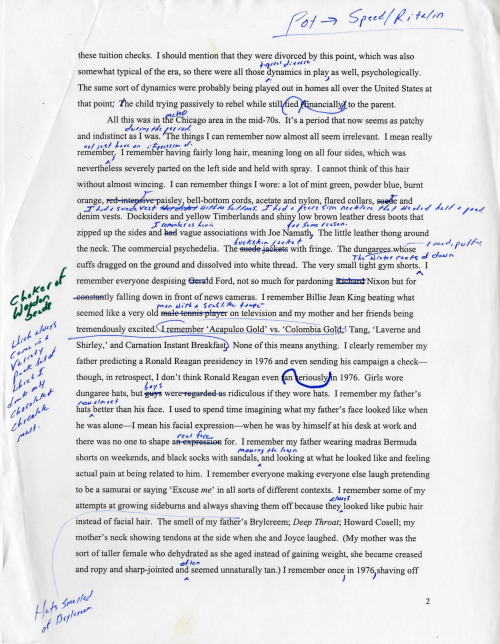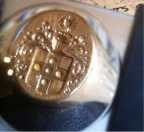In the David Foster Wallace Archive: Part 1/3
 |
| part of the archive in the stacks |
I returned from Austin a few weeks ago and while there was
able to spend 5 hours examining various documents in the David Foster Wallace
(DFW) archive at the Harry Ransom Center (HRC) of the University of Texas. And
so, I was also able to examine hand written drafts, heavily notated typescripts
and other fragments from the birth of Infinite Jest (IJ). Wow. I hope this
short essay will transmit a sense of the humanity and process of Wallace as
writer and man. I paged through books
from his personal library w/ his marginalia inscribed; I chose books that I
have some familiarity with: The Moviegoer – Walker Percy, Against
Interpretation – Susan Sontag, and The Fire Next Time – James Baldwin.
Pretty cool stuff, which we can imagine indicate the portions of the texts he found
most salient – especially the hand written notes in the Percy, which he taught,
at Pomona, I believe.
 |
| DFW's marginalia in The Moviegoer has a similar appearance |
Showing images from the things I reviewed would be ideal,
but doing so would require time and money to acquire copyroght permissions I do not have. I will, however, show a
few examples of similar items (in appearance, if not content) so the physical
gist can be understood. It should also go without saying that nothing I write
here could in any way be construed as the result of an authoritative study of
the archive. It is just a glimpse of my own introduction to a fragment of the
materials available.
There is a whole set of rules, which seem pretty much
appropriate for such a place, that must be followed to do archival research at
the HRC. I had to create an account with ‘logon’ username and password. I
emailed staff ahead of time to make sure there were no unknown obstacles to stall
or prevent access to the material. The archive staff was and is very helpful.
Upon arrival one must watch a short video on handling archival materials, photography
requirements (as a research and note taking aid one is allowed to use a cell
phone camera to photograph documents to refer to in the future - this privilege
also requires a solemn vow to not share the images), copyright rules and so on.
I was only allowed to bring into the archive reading room my phone or a
computer and pencil and paper provided by the HRC. Lockers are provided for
other belongings. Once issued a pass for the reading room, entry is gained, I
was shown how to call up material by computer and request boxes containing
catalogued folders of manuscript and typescript matter. I also requested a few
books from his personal library.
I was invited to settle in at a work table in front of the
on duty librarians and then the requested material wass placed on a separate
table between the researcher work tables and the librarians. One is only allowed to
take one folder from an archive box at a time to the work table. Several books
can be brought to the work table simultaneously. And this I did with some reverence
and not just a bit of trepidation.
Knowing that my time in the archive would be limited to a
few breaks in a conference I was attending, a strategy had to be developed
would enable me to get to know DFW a little bit and to get a small sense of the
evolution of IJ. Photographing pages became key. I decided to concentrate on materials that
were, as best I could tell from the catalogue notes, from parts of the book that are arranged in
the first few hundred pages as we know them now.
I have 50 photographs, of mostly whole pages of hand written
manuscript and/or annotated typescript. Some are different iterations of the
same scene. Upon returning home I
identified the pages in the current print edition that correspond to the
material in the manuscript pages. Here
are a few details from the examples I collected:
 |
| This is from The Pale King, but looks similar to the IJ stuff in appearance. Different pen colors, underlines, rearrangements, etc. |
- There is a cover to writing sent to his agent, Bonnie Nadell, titled ‘First Two Sections’ and then on the next line ‘Infinite Jest’ and this work does not start in Tucson in the Year of Glad.
- This cover clearly indicates the document is “INTENDED ONLY FOR THE RETINAS OF PEOPLE TO WHOM IT’S EXPLICITLY SENT”
- This is followed by a section titled ‘Preliminary Throat Clearings’ in type, but with a handwritten ‘Cut?’ at the top. It features the dedication (which still exists, though slightly modified), an epigraph from Blake’s Marriage of Heaven and Hell which reads: ‘Sorrow brings forth’ and definitions of addict and addiction from the Oxford English Dictionary (OED).
- The scene that starts this part/beginning of the typescript is found on P37, with Hal going his father, James Orin Incandenza (JOI) who is disguised as a ‘professional conversationalist.’ This gets pretty interesting as I also came across, what I presume to be an earlier incarnation of the scene, in which the ‘Hal’ character is called ‘David’ and it is putatively dated, April 1, 1974. DFW was 13/14 that year.
- Another typescript has the year of this episode taking place in the Year of the Perdue Wonderchicken, which is the scratched out and then the Year of the Trial-Size Dove Bar is inked in and then, that is scratched out and finally the Year of the Tuck’s Medicated Pad is written in and that is what appears in the final text.
- The scene DFW attempted to render in the ‘African-American Vernacular’ that begins on P37 with ‘Wardine say…’ looks to have been earmarked for the Year of the Whisper Quiet Maytag Dishwasher. However that was crossed out in pen and the Year of the Trial-Size Dove Bar was written in in blue ballpoint ink – which is the year of subsidized time that now appears in the text.
- What is still more interesting, imho, is another version of the same scene titled ‘Las Meninas.’ It is essentially the same thing, but on the bottom of its typed second page is an indication that it was written while he was in grad school at the University of Arizona.
- On P33 of the text we are introduced to the last medical attache. From the material I observed he went from one quarter to one half ‘ethnic Arab’ as the drafts proceeded.
- On the back of a typescript page are handwritten sentences which appear in modified form in the middle of P35. It is a description of the teleputer and the medical attache’s relationship with it. Adjectives, word order and other changes occur on the way to the final edition.
More on IJ in Part 2/3 and a few notes on his books as well
as any conclusions I may come to in Part 3/3.


<< Home